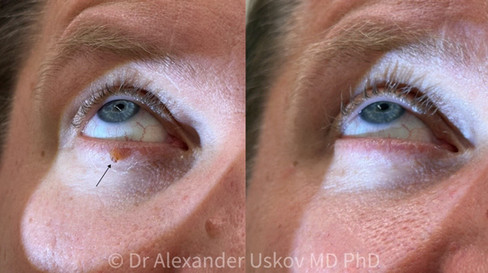Laser removal of papillomas on the eyelids
- gertnulk
- Aug 17
- 3 min read
In our clinic, we help patients with various benign growths on the eyelids and the area around the eyes.
To keep the description simple and easy to understand, we use the familiar and straightforward term “papillomas.”

Eyelid papillomas are benign growths that develop on the thin and sensitive skin of the eyelids. Although they are non-cancerous, they often cause discomfort, aesthetic concerns, and even ophthalmological complications.
At the clinic of international expert Dr. Uskov, we remove eyelid skin lesions using advanced medical laser technologies, ensuring maximum precision, safety, and an aesthetically pleasing result.
Why remove it
Eyelid papillomas can occur at any age. They may:
interfere with the natural blinking reflex,
cause irritation when in contact with eyelashes or lenses,
be a source of psychological discomfort,
become injured or inflamed.
In some cases, papillomas are caused by the human papillomavirus (HPV), which carries a risk of spreading to surrounding areas of the skin.

And why a laser is the best tool for the job
Removing papillomas in the eyelid area requires extreme precision. Laser treatment offers several key advantages:
Selective action — minimal risk of damaging healthy tissue
No direct contact with the skin — high sterility and reduced risk of recurrence
Vessel coagulation — minimal bleeding
Aesthetic result — no stitches or scars
Rapid healing — due to controlled depth of action
The course of treatment
In-person consultation and diagnosis
During the initial appointment, the doctor conducts:
visual and palpative examination of the growth
digital dermatoscopy to clarify its structure
if necessary, Wood’s lamp inspection and infrared scanning
exclusion of malignant changes (in rare cases, a biopsy or histological examination may be required)
Based on the examination, a personalized removal protocol is created, taking into account the number, location, and depth of the lesions.
Laser removal
Technologies used: CO₂ laser, Er:YAG, Nd:YAG, depending on structure and location
Procedure duration: 5–20 minutes
Anesthesia: local anesthesia via drops or gel; injections are rarely needed
Eye protection: special scleral shields are used if necessary to prevent injury
In 90% of cases, a single procedure is sufficient, though sometimes a follow-up correction is required 4–8 weeks later.
Real before-and-after results of eyelid papilloma removal are presented in our gallery — you can see them for yourself.
What affects the result?
size and depth of the papilloma
number of papillomas
patient’s age
location (mobile or fixed part of the eyelid)
individual skin characteristics and tendency to hyperpigmentation
presence of concomitant ophthalmological conditions
Post procedure recovery and aftercare
Immediately after the procedure, redness or slight swelling may appear (up to 24 hours)
A thin, dry crust forms at the site of the papilloma, which falls off within 4–7 days
Makeup and contact lenses can usually be used after complete healing (4–10 days)
Sunscreen (SPF 50+) must be applied for 4 weeks
It is very important not to touch or remove the crust — this is key to avoiding scars and pigment changes. Additional recommendations are provided during the in-person consultation.
Safety first
Working on the eyelid area requires:
expert skill of the physician
precise knowledge of orbital anatomy
use of medical equipment with depth control
adherence to all eye protection standards
At Dr. Uskov’s clinic:
only clinically certified laser technologies are used
procedures are performed by doctors trained in dermatology and laser therapy
each case is considered individually, with all risks evaluated
Every patient is unique
The outcome always depends on:
patient’s skin type
tissue response to laser treatment
adherence to post-procedure recommendations (hygiene, care, sun protection)












































































Comments